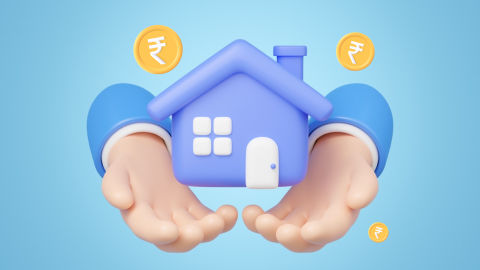Understanding the conversion between kanal and gaj can also be crucial when valuing land, especially if you plan to secure aloan against property. Accurate land measurements ensure that the property is correctly valued, which is essential when using it as collateral for a loan. By knowing how to convert kanal to gaj, you can make more informed decisions during property transactions, ensuring a smoother process whether you're selling, buying, or borrowing against your land.
Read on to understand what these units are, the importance of converting from kanal to gaj, and how you can make the conversion correctly.
What is a kanal?
Akanalis a traditional unit of area measurement commonly used in the Indian subcontinent. A single kanal is typically considered to represent a large area of land. It is most often used in real estate transactions and property descriptions, especially when discussing residential plots or agricultural land. The size of one kanal can vary slightly depending on the local region, but the most common measurement for one kanal is505.857 square metersor20 marlas.The kanal unit has its roots in historical land measurement systems that were designed to make land transactions more practical. This made it easier for people to quickly understand the size of a plot of land without needing to rely on complicated or unfamiliar units of measurement.
What is a gaj?
Agaj(also spelledgaz) is another traditional unit of area used in South Asia, especially in the Indian subcontinent. The term "gaj" is often used interchangeably with "yard" in some contexts. However, in land measurements,1 gaj equals 1 square yard, which is approximately0.836 square meters.Gaj is typically used to measure smaller areas, such as the size of a room, a small plot of land, or even fabric. When it comes to real estate, gaj is more commonly used for plotting land at a finer scale, particularly for residential homes or in densely populated areas.
Importance of converting kanal to gaj
Understanding the relationship between kanal and gaj is essential, especially when dealing with land transactions.Land developers,real estate agents, andhomebuyersoften need to make conversions between these two units to accurately estimate the area and determine the value of a property. By converting kanal into gaj, you can have a clearer understanding of the actual land size and make more informed decisions. For example, if you are buying land and the plot is measured in kanal, but you are more familiar with gaj, the conversion helps you visualise the land's size in a unit you are more comfortable with. Converting kanal to gaj can also be important for legal purposes, as contracts and documents often use specific units of measurement to define property boundaries.Kanal to gaj conversion formula
To convert from kanal to gaj, you need to know the exact relationship between the two units. The general formula is:1 kanal = 20 marlas = 80 gaj
Since1 marlais typically equal to4 gaj, multiplying the number of marlas by 4 gives the number of gaj in one kanal. Therefore,one kanal equals 80 gaj. This is the standard conversion, but it is important to note that regional variations can exist, so always verify the conversion for your specific area.
For quick and easy conversions between various land measurement units, including kanal and gaj, you can use anarea conversion calculatoravailable online. These tools allow you to input a value in one unit and instantly convert it to another. Whether you are converting kanal to gaj or vice versa, these calculators can save time and reduce the chance of errors.
Step-by-step guide to convert kanal to gaj
If you prefer to manually calculate the conversion, follow these simple steps:Identify the number of kanalsyou want to convert.
Multiply the number of kanals by 80(since 1 kanal = 80 gaj).
The result is the area in gaj.
For example, if you have 5 kanals of land:
5kanals×80=400gaj
This means that 5 kanals of land is equal to 400 gaj.
Kanal to gaj conversion
Here is a simple table to help you quickly convert kanal to gaj:| Kanals | Gaj |
| 1 | 80 |
| 2 | 160 |
| 3 | 240 |
| 4 | 320 |
| 5 | 400 |
| 10 | 800 |
| 20 | 1600 |
Online kanal to gaj conversion calculator
For even more convenience, an online area conversion calculator make it easy to convert between kanal and gaj. These calculators only require you to input the number of kanals, and they will automatically give you the result in gaj. These online tools are available on websites dedicated to real estate, land measurement, or conversion services. They are accurate, fast, and convenient for anyone looking to perform area conversions on the go.Common mistakes to avoid in kanal to gaj conversion
When converting between kanal and gaj, a few common mistakes can lead to confusion:Not accounting for regional variations: The size of a kanal can vary in different regions. Always confirm the exact measurement of one kanal in your locality.
Forgetting to multiply by 80: One of the most common errors is forgetting to multiply by 80 when converting kanal to gaj.
Confusing units: It is important to keep track of whether you're working with area units or linear measurements. Ayardandgajare linear, whilekanalis an area measurement.
Applications of kanal to gaj conversion in real estate
In the real estate sector,accurate land measurementsare crucial for determining the value of property, planning construction projects, and negotiating prices. Whether buying or selling property, understanding the size in familiar units such as gaj can help in making better decisions. For instance, a property described as "10 kanals" may sound large, but knowing the conversion to gaj can give you a clearer sense of its true size.Regional variations in kanal and gaj measurements
While the kanal and gaj are widely used in India, it is important to note that their exact measurements can vary depending on the region. For example, a kanal might be slightly larger, while in certain areas of India, a gaj might differ in size. Always check local norms to ensure that the conversions are accurate for your specific location.Historical context of kanal and gaj as land measurement units
Thekanalandgajoriginated from historical land measurement systems used during the Mughal Empire and even earlier. These units were designed for practical use in an agrarian society where measuring large areas of land quickly was essential. Over time, these units became standardized, but regional differences still persist today.Benefits of accurate land measurement conversions
Prevents misunderstandings: Ensures all parties involved (buyers, sellers, and agents) have a clear understanding of land size, avoiding confusion.Fair property valuation: Accurate conversions lead to proper pricing, ensuring the property is neither undervalued nor overvalued.
Legal compliance: Correct measurements are crucial for legal documents, land registration, and official contracts, ensuring compliance with local laws.
Informed decision-making: Buyers and investors can make better decisions about purchasing, developing, or selling land with accurate measurements.
Efficient planning: Developers and construction planners rely on accurate land measurements to design layouts and make use of available space effectively.
Transparency in transactions: Clear, accurate conversions foster trust and transparency between parties, reducing disputes.
Cost savings: Avoiding errors in measurements helps prevent costly mistakes during construction or land development.
Adaptability to regional variations: Correct conversions account for local measurement standards, providing consistency in different regions.
Conclusion
Understanding how to convert between kanal and gaj is essential for anyone involved in land transactions in regions where these units are used. Whether you are a homeowner, real estate investor, or developer, knowing how to calculate these conversions can help you make informed decisions. Accurate land measurements are also crucial when securing amortgage loan, as the value of the property plays a key role in determining the loan amount you can receive.Using tools like area conversion calculators can simplify the process, ensuring accuracy and preventing mistakes. So, next time you encounter land measurements, you’ll have the knowledge to confidently convert kanal to gaj and make well-informed decisions, whether you're buying, selling, or leveraging your property for a mortgage loan.




